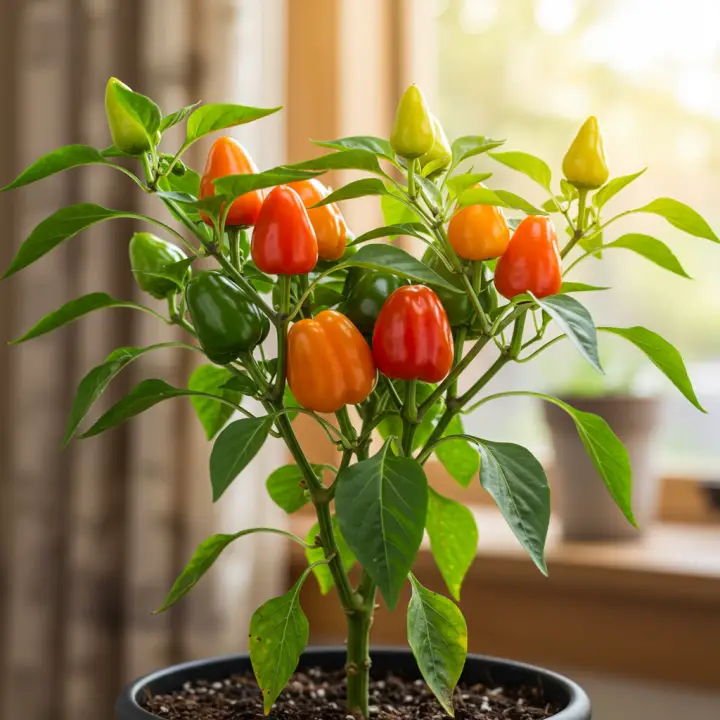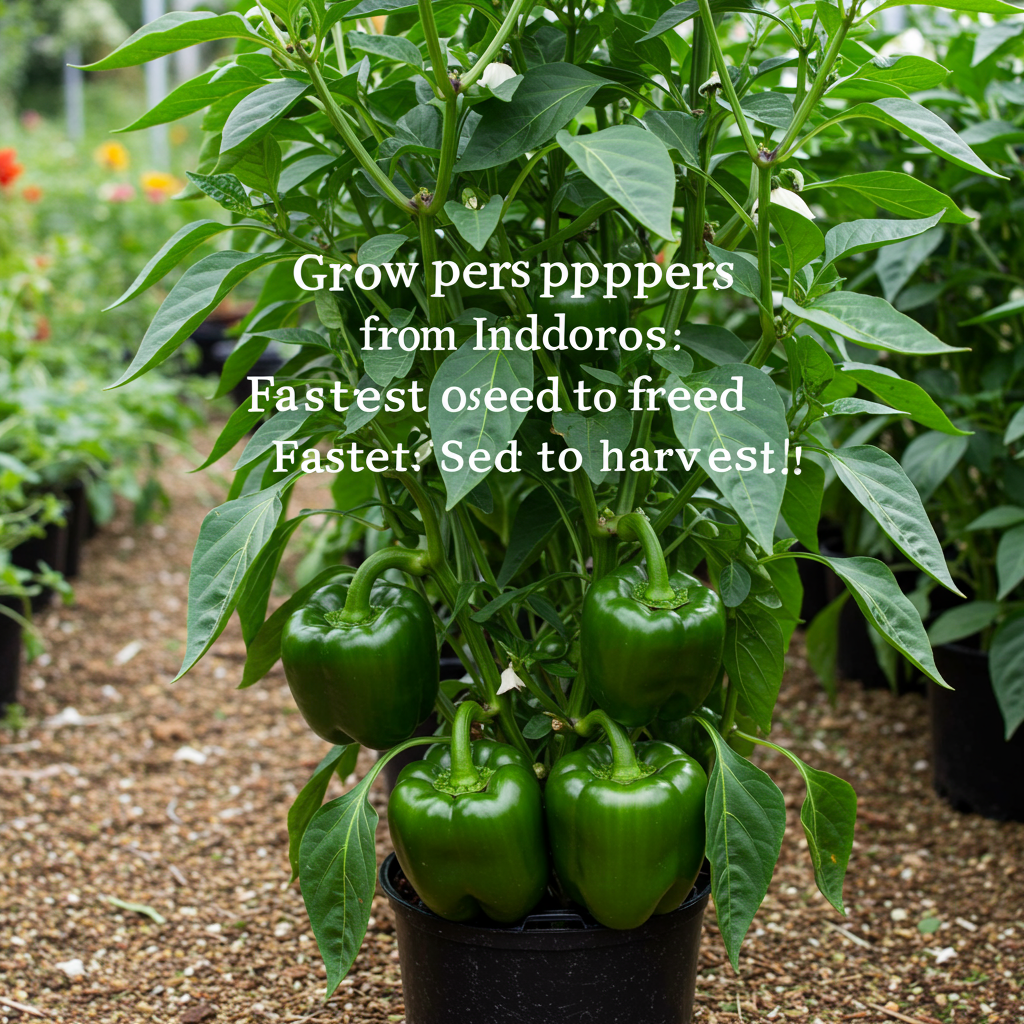Growing your own peppers from scratch can be an incredibly rewarding experience. For many, the journey begins indoors, offering a controlled environment to nurture delicate seedlings. Understanding the timeline involved is key to success. Growing peppers from seed indoors typically takes anywhere from 3 to 6 months from planting to your first harvest, with crucial stages impacting the overall duration
.
Your Indoor Pepper Growing Journey: From Tiny Seed to Flavorful Fruit
Embarking on the journey of growing peppers from seed indoors is an exciting prospect. It allows you to cultivate unique varieties, enjoy fresh produce, and even extend your growing season. However, patience is a virtue when it comes to peppers. This guide will help you understand the various stages and timeframes, ensuring you’re well-prepared for each step.
The Pepper Growing Timeline: Key Stages and Durations
The total time from planting a pepper seed to harvesting a ripe pepper isn’t a single, fixed number. Instead, it’s a sum of several distinct growth phases, each with its own approximate duration.
Germination: The First Sprout
This is where the magic begins – the tiny seed sprouts into a seedling.
- Duration: 7 to 21 days (1 to 3 weeks)
- What Happens: The seed cracks open, and a root emerges, followed by the first tiny leaves (cotyledons).
- Factors: Warmth (75-85°F / 24-29°C is ideal), consistent moisture, and good quality seeds are crucial. Cooler temperatures can significantly extend this period.
- Tip: Using a heat mat can dramatically speed up germination for peppers.
Seedling Stage: From Cotyledons to True Leaves
Once your seeds have germinated, they enter a vulnerable but vital growth phase.
- Duration: 2 to 4 weeks post-germination
- What Happens: The initial cotyledons emerge, followed by the development of the “true leaves,” which look like miniature versions of adult pepper leaves. The plant begins to develop a stronger root system.
- Care: During this stage, seedlings need plenty of light (12-16 hours daily, often requiring grow lights for indoor setups), consistent humidity, and careful watering. Avoid overwatering.
Vegetative Growth & Transplanting
As your seedlings mature, they’ll need more space to thrive.
- Duration: 4 to 6 weeks after sprouting
- What Happens: The plants grow larger, developing multiple sets of true leaves and a more robust stem. Once they have 3-4 sets of true leaves and a good root ball, they are ready to be transplanted into larger pots (e.g., 1-gallon pots) for continued indoor growth.
- Care: Increase light intensity if needed. Begin very light fertilization once true leaves appear and the plant is actively growing.
Flowering & Fruit Set: Anticipating the Harvest
This is a critical stage where your plants prepare to produce fruit.
- Duration: Approximately 2 to 3 months from initial sprouting
- What Happens: Your pepper plants will start to produce flower buds, which then open into small, white or purple flowers. Successful pollination leads to “fruit set,” where the base of the flower swells into a tiny pepper.
- Indoor Specifics: Indoor plants often require manual pollination. Gently shake the plant or use a small, soft brush to transfer pollen between flowers to ensure fruit production.
Fruiting & Maturation: The Reward
The final stage, where your hard work pays off with delicious peppers.
- Duration: 1.5 to 3 months from fruit set to ripeness (can vary significantly by variety)
- What Happens: The tiny peppers grow to their full size and then begin to change color, signaling ripeness. Bell peppers, for instance, might start green and turn red, yellow, or orange.
- Care: Consistent watering, adequate light, and proper nutrition (especially phosphorus and potassium) are essential for good fruit development and flavor. Some peppers can be harvested green, while others develop their full flavor and heat when fully ripened.
Factors Influencing Your Indoor Pepper Growing Timeline
While the above provides a general timeline, several factors can significantly influence how long it takes to grow peppers from seed indoors.
- Pepper Variety: This is perhaps the biggest factor. Some early-maturing varieties (e.g., certain bell peppers, jalapeños) might produce fruit in as little as 60-75 days from transplant, while longer-season hot peppers (e.g., Habanero, Scotch Bonnet) can take 90-120 days or even longer to ripen fully.
- Temperature and Humidity: Optimal temperatures (70-80°F / 21-27°C) and moderate humidity ensure steady, healthy growth. Fluctuations or consistently low temperatures slow everything down.
- Light Quality and Duration: Peppers are sun-loving plants. Indoors, this means providing at least 12-16 hours of strong, full-spectrum light daily using appropriate grow lights. Inadequate light leads to leggy, weak plants and delayed flowering/fruiting.
- Soil and Nutrients: A well-draining, nutrient-rich potting mix is essential. Regular, balanced fertilization (starting gently after true leaves appear) ensures the plants have the energy to grow and produce. Deficiencies can stunt growth.
- Seed Age and Viability: Older seeds may take longer to germinate or might not sprout at all. Always use fresh, reputable seeds for the best results.
Speeding Up the Process: Tips for Faster Growth
While you can’t rush nature entirely, you can optimize conditions to encourage faster growth:
- Use a Heat Mat: For germination, it’s a game-changer.
- Provide Ample Light: Invest in good quality grow lights and ensure they are positioned correctly to prevent leggy growth.
- Pre-Soak Seeds: Soaking seeds in warm water for a few hours (or even overnight) can soften the seed coat and encourage quicker germination.
- Maintain Optimal Temperatures: Keep ambient temperatures consistently warm throughout the plant’s life cycle.
- Proper Watering and Fertilizing: Avoid water stress (both over and under-watering). Feed your plants appropriately with a balanced fertilizer.
FAQs about Growing Peppers from Seed Indoors
Here are some common questions about growing peppers from seed indoors:
Q1: Do pepper seeds need light to germinate?
No, pepper seeds do not need light to germinate. They actually prefer darkness. Light becomes essential once the seedlings sprout.
Q2: Can I use regular potting soil for pepper seeds?
It’s better to use a seed-starting mix. These mixes are sterile, lightweight, and have a finer texture, which is ideal for delicate seedlings and prevents damping-off disease. You can transition to regular potting soil when transplanting into larger pots.
Q3: How much light do pepper seedlings need?
Once sprouted, pepper seedlings need 12-16 hours of bright, full-spectrum light per day. Grow lights are typically necessary indoors to meet this requirement.
Q4: When should I fertilize my pepper seedlings?
Begin fertilizing very lightly once your seedlings have developed a few sets of true leaves. Use a diluted, balanced liquid fertilizer (about ¼ to ½ strength) every two weeks.
Q5: Why aren’t my indoor pepper plants flowering or setting fruit?
Common reasons include insufficient light, incorrect temperatures (too cold or too hot), lack of pollination, or nutrient imbalances (too much nitrogen can cause lush foliage but inhibit flowering). Ensure you’re providing sufficient light, steady warm temperatures, and manually pollinating if needed.
Conclusion
Growing peppers from seed indoors is a fulfilling journey that can span from 3 to 6 months, depending heavily on the pepper variety and the care you provide. From the magical moment of germination, through the tender seedling stage, robust vegetative growth, and finally to the exciting period of flowering and fruiting, each phase requires patience and attention. By understanding the typical timeline and optimizing factors like temperature, light, and nutrients, you’ll be well on your way to enjoying a bountiful harvest of fresh, homegrown peppers right from your indoor garden. Happy growing!

